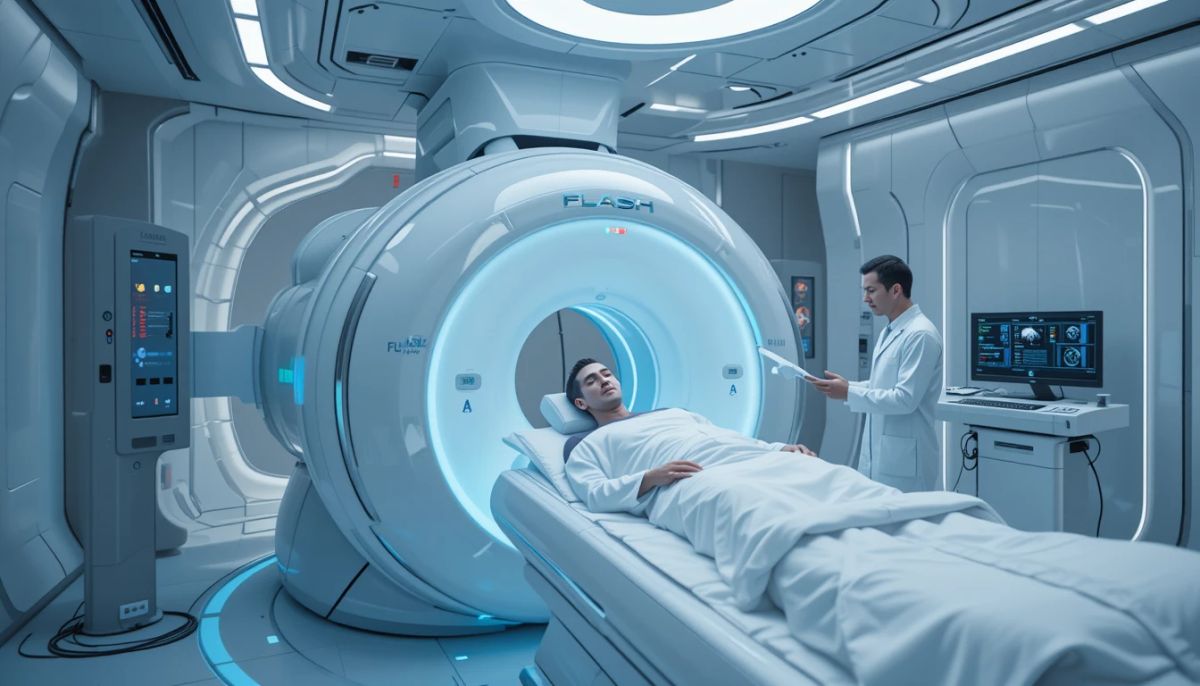In the ever-evolving world of cancer treatment, a groundbreaking technique known as FLASH radiotherapy has emerged as a potential game-changer. This innovative approach to radiation therapy promises to deliver powerful cancer-fighting effects while significantly reducing damage to healthy tissues. As we step into 2025, FLASH radiotherapy is on the cusp of transforming oncology as we know it.
What is FLASH Radiotherapy?
FLASH radiotherapy, also known as FLASH-RT, is an ultra-high dose-rate radiation treatment that delivers therapeutic doses of radiation in a fraction of a second. Unlike conventional radiotherapy, which can take several minutes to administer, FLASH-RT completes the treatment in milliseconds.
The key characteristics of FLASH-RT include:
- Delivery of radiation at rates exceeding 40 Gy/s
- Treatment times of less than 200 milliseconds
- Potential to maintain tumor control while reducing toxicity to surrounding healthy tissues
The Science Behind FLASH
The FLASH effect, which is the core principle behind this therapy, is believed to occur due to several unique biological mechanisms:
- Transient hypoxia: The ultra-fast delivery of radiation causes a rapid depletion of oxygen in the treated area, which paradoxically protects normal cells while maintaining the anti-tumor effect.
- Reduced DNA damage: FLASH-RT appears to cause fewer DNA damage sites and chromosomal aberrations in healthy cells compared to conventional radiotherapy.
- Modulation of immune responses: The treatment may alter immune and inflammatory responses, potentially contributing to its tissue-sparing effects.
Clinical Progress and Promising Results
The journey of FLASH radiotherapy from laboratory experiments to clinical trials has been remarkably swift. As of January 2025, several significant milestones have been achieved:
FAST-01 Trial
- The first-in-human trial, known as FAST-01, demonstrated the safety and efficacy of FLASH-RT for treating bone metastases. Key findings include:67% of treated sites experienced pain relief
- No unexpected side effects were reported
- The average time on the treatment couch was just 18.9 minutes per patient
FAST-02 Trial
Building on the success of FAST-01, researchers at Cincinnati Children's / University of Cincinnati Medical Center Proton Therapy Center initiated the FAST-02 trial, focusing on cancers in the chest bones.
Advantages of FLASH Radiotherapy
FLASH-RT offers several potential benefits over conventional radiotherapy:
- Reduced treatment time: From months to days, significantly improving patient comfort and potentially increasing treatment capacity.
- Minimized side effects: The ultra-fast delivery appears to cause less damage to healthy tissues, potentially allowing for higher doses to be administered safely.
- Improved efficacy: Early studies suggest that FLASH-RT may be effective against tumors resistant to conventional treatments.
- Cost-effectiveness: Shorter treatment times could lead to reduced healthcare costs and improved access to treatment, especially in areas with limited resources.
Challenges and Future Directions
Despite its promise, FLASH radiotherapy faces several hurdles on its path to widespread clinical implementation:
- Technological constraints: Developing equipment capable of delivering ultra-high dose rates consistently and safely is a significant challenge.
- Biological understanding: While the FLASH effect has been observed, the exact mechanisms are not fully understood, requiring further research.
- Clinical validation: More extensive clinical trials are needed to confirm the safety and efficacy of FLASH-RT across various cancer types and patient populations.
The Road Ahead
As we look to the future, the potential impact of FLASH radiotherapy on cancer treatment is immense. Researchers and clinicians are working tirelessly to overcome the current challenges and bring this revolutionary treatment to patients worldwide.
Ongoing Developments
- Modification of existing equipment: Efforts are underway to adapt conventional accelerators to achieve the ultra-high dose rates required for FLASH-RT.
- Expansion of treatment capabilities: Research is focused on increasing beam current limits, repetition rates, and developing new RF sources for high pulsed power delivery.
- Exploration of new applications: Future developments may include FLASH ion therapy, real-time MRI guidance during treatment, and PET imaging for dose verification.
Conclusion
FLASH radiotherapy represents a paradigm shift in cancer treatment, offering the potential to dramatically improve patient outcomes while reducing side effects and treatment times. As clinical trials progress and technology advances, we may be on the brink of a new era in radiation oncology.
The coming years will be crucial in determining the full potential of FLASH-RT. With the first planned clinical implementations set for 2025, the oncology community eagerly anticipates the results that could reshape cancer treatment protocols worldwide.
FAQs
How does FLASH radiotherapy differ from conventional radiotherapy?
FLASH-RT delivers ultra-high dose rates of radiation in milliseconds, while conventional radiotherapy takes minutes to administer. This ultra-fast delivery appears to reduce damage to healthy tissues while maintaining tumor control.
Is FLASH radiotherapy available for all types of cancer?
Currently, FLASH-RT is still in clinical trials and not widely available. Early studies have focused on bone metastases, but research is ongoing for various cancer types.
What are the potential side effects of FLASH radiotherapy?
Early trials suggest that FLASH-RT may have fewer side effects than conventional radiotherapy, but more research is needed to fully understand its long-term effects.
How soon could FLASH radiotherapy become widely available?
While the first clinical implementations are planned for 2025, widespread availability will depend on the results of ongoing trials and technological developments.
Can FLASH radiotherapy be combined with other cancer treatments?
Research is ongoing to explore potential combinations of FLASH-RT with other cancer therapies, but it's too early to draw definitive conclusions about its efficacy in combination treatments.
